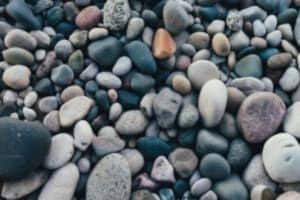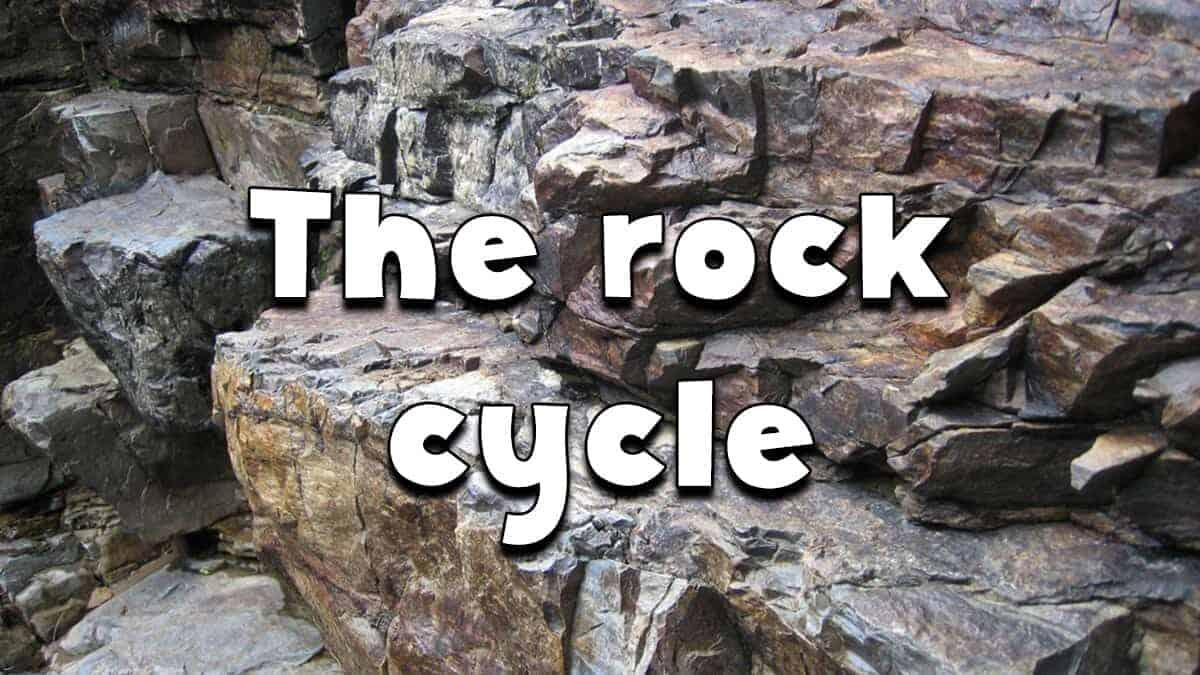Weathering
Weathering is the breakdown of rocks at the Earth’s surface, by the action of rainwater, extremes of temperature, and biological activity. It does not involve the removal of rock material.
There are three types of weathering, physical, chemical and biological.
How is erosion different to weathering?
Erosion is the process by which soil and rock particles are worn away and moved elsewhere by wind, water or ice. Weathering involves no moving agent of transport.
Erosion and Transport
Erosion
Erosion is the process by which soil and rock particles are worn away and moved elsewhere by gravity, or by a moving transport agent – wind, water or ice.
Transport refers to the processes by which the sediment is moved along – for example, pebbles rolled along a river-bed or sea shore, sand grains whipped up by the wind, salts carried in solution.
How is erosion different to weathering?
Erosion involves removal of solid material by a transporting agent. Weathering is the breakdown of rock into fragments at the Earth’s surface. No movement is involved in weathering.
Deposition is the laying down of sediment carried by wind, water, or ice. Sediment can be transported as pebbles, sand & mud, or as salts dissolved in water. Salts may later be deposited by organic activity (e.g. as sea-shells) or by evaporation.
Burial and Compaction
Layers of sedimentary rocks in the Grand Canyon, USA.
How do great thicknesses of sedimentary rocks (see photo) build up, and how does the loose sediment get turned into hard rock?
As layers are piled one upon another, the sediments beneath are buried, sometimes by hundreds of metres of sediment above. The weight of these layers compacts (squashes down) the sediment grains. Minerals deposited from water in the spaces between the sediment grains gradually cements them together. Compaction and cementation are explained in the next two pages.
The Principle of Superposition:
In a series of rock layers like those in the picture, we see that the layers at the bottom of the canyon must have been deposited first – in other words, they are the oldest rocks, whilst the rocks at the top are the youngest.
This “principle of superposition” can often be used to work out the relative ages of different rock layers, but can you think of situations where it might not work?
What if the rocks have been folded, for example?
Deformation and Metamorphism
Jane A Gilotti, University of Iowa
The Earth’s crust is slowly moving. Did you know that the Atlantic Ocean is getting wider at about the rate your fingernails grow, or that India is barging its way slowly northward into the continent of Asia?
The huge forces that move continents stretch and squash parts of the Earth’s crust., generating earthquakes and building mountains. They cause rocks near the surface to be fractured and faulted. At greater depth, the heat and pressure involved can cause folding and/or metamorphism.
Dickson Fjord in Greenland: This huge cliff (over 2,000 metres high!) is made of a metamorphic rock called gneiss.
This was once a series of both igneous and sedimentary rocks, which were deeply buried, folded by huge forces, and completely recrystallised at high temperature and pressure to form this beautifully banded and folded rock.
Uplift – the Key to the Rock Cycle
Understanding the idea of Uplift is the key to making sense of the rock cycle, as it allows us to see rocks that were once deeply buried beneath the surface.
If rocks did not get uplifted to form hills and mountains, then the processes of weathering and erosion would long ago have reduced much of the world’s land-masses to low-lying, flat plains. Weathering and erosion, transport and deposition would all effectively stop.
Ammonite: French Alps
Scientists believe that, if all these active processes of the rock cycle ceased to operate, then our planet would cease to be able to support any life.
Mount Everest is made of limestone that must have originally formed on an ancient sea floor because it contains fossils of marine creatures.
How did these – and many other – rocks formed beneath the sea end up at the tops of mountains?
Mid-ocean volcanoes
Where plates move apart, the hot rock of the Earth’s mantle layer gets closer to the surface and begins to melt, forming runny basalt magma.
Ocean-edge volcanoes
Where plates come together, the ocean floor sinks down beneath the continent. As it gets hotter, water is released, which helps to melt the hot mantle rock, producing sticky andesite magma.
Mountain belts
Sometimes continental rocks are also melted, producing. very sticky granite (or rhyolite) magma, but this rarely reaches the surface.
Magma can have different compositions depending on how it was formed. Magma also varies in temperature, and in how much dissolved gas it contains.
All of these factors control the viscosity of the magma (whether it is relatively runny or very thick and sticky).
Viscosity, in turn, controls how magma behaves as it rises through the crust, and erupts at the surface.
Cooling rate and grain size:
The rate at which magma cools controls the grain size of the igneous rock that is formed. More rapid cooling produces finer-grained rocks. Find out more on Cooling Rate and Grain Size.
Volcanoes:
Magmas that are hot and relatively runny are more likely to reach the surface in volcanic eruptions than cooler, more viscous magmas. Find out more on Volcanoes & Extrusive Igneous Rocks.
Igneous intrusions:
Sometimes, magma does not reach the surface. Instead, it stays within the crust, where it slowly cools and crystallises to form igneous intrusions. Find out more on Igneous Intrusions.
The rock cycle describes the process of the formation, breakdown and reformation of rocks.

Weathering
- Weathering is the breakdown of rocks at the Earth’s surface, by the action of rainwater, extremes of temperature, and biological activity. It does not involve the removal of rock material
- There are three types of weathering, physical, chemical and biological.
Erosion & Transport
- Erosion is the process by which soil and rock particles are worn away and moved elsewhere by wind, water or ice. Weathering involves no moving agent of transport.
- Transport refers to the cycle processes by which the sediment is moved along – for example, pebbles rolled along a river-bed or sea shore, sand grains whipped up by the wind, salts carried in solution.
Deposition
- Deposition is the laying down of sediment carried by wind, water, or ice. Sediment can be transported as pebbles, sand & mud, or as salts dissolved in water.
- Salts may later be deposited by organic activity (e.g. as sea-shells) or by evaporation.
Burial and Compaction
- As layers are piled one upon another, the sediments beneath are buried, sometimes by hundreds of metres of sediment above. The weight of these layers compacts (squashes down) the sediment grains.
- Minerals deposited from water in the spaces between the sediment grains gradually cements them together.
Deformation and Metamorphism
- The Earth’s crust is slowly moving. Did you know that the Atlantic Ocean is getting wider at about the rate your fingernails grow, or that India is barging its way slowly northward into the continent of Asia?
- The huge forces that move continents stretch and squash parts of the Earth’s crust., generating earthquakes and building mountains. They cause rocks near the surface to be fractured and faulted.
- At greater depth, the heat and pressure involved can cause folding and/or metamorphism.
Uplift
- Uplift is the key to the rock cycle, as it allows us to see rocks that were once deeply buried beneath the surface.
- If rocks did not get uplifted to form hills and mountains, then the processes of weathering and erosion would long ago have reduced much of the world’s land-masses to low-lying, flat plains.
- Weathering and erosion, transport and deposition would all effectively stop.
- Mount Everest is made of limestone that must have originally formed on an ancient sea floor because it contains fossils of marine creatures.
Melting
 Rocks are made up of different minerals that have different melting points. When hot rocks begin to melt deep down beneath the surface, some of the minerals start to melt but others stay solid.
Rocks are made up of different minerals that have different melting points. When hot rocks begin to melt deep down beneath the surface, some of the minerals start to melt but others stay solid.- The rock of the Earth’s mantle layer only begins to melt in a few zones where it is disturbed in some way
- Rocks melt because of the heat beneath the Earth’s surface, as well as other factors such as changes in pressure, or the presence of water within the rock.
- Magma reaches the surface because of pressure squeezes the rock like a sponge, forcing the melted material (magma) to rise toward the surface.
Crystallisation of Magma
- Magma can have different compositions depending on how it was formed.
- Magma also varies in temperature, and in how much dissolved gas it contains. All of these factors control the viscosity of the magma (whether it is relatively runny or very thick and sticky).
- Viscosity, in turn, controls how magma behaves as it rises through the crust, and erupts at the surface.
- The rate at which magma cools controls the grain size of the igneous rock that is formed. More rapid cooling produces finer-grained rocks.
> Visit the Geology Rocks homepage
> Download the free Geology Rocks podcast from iTunes




